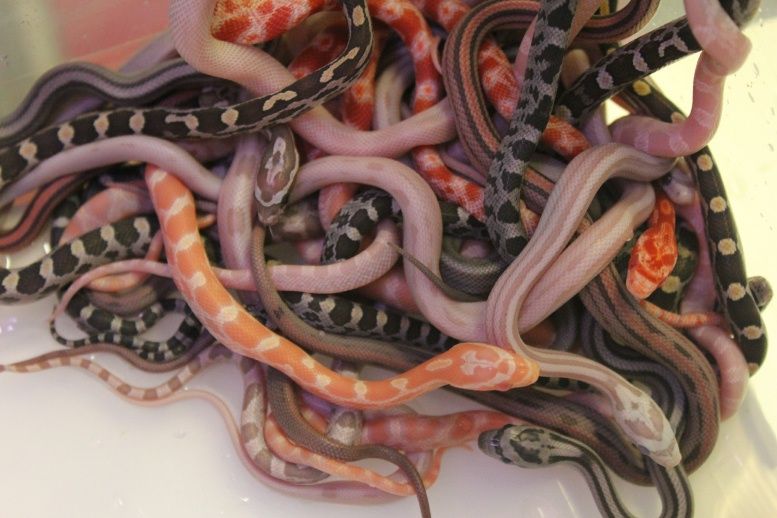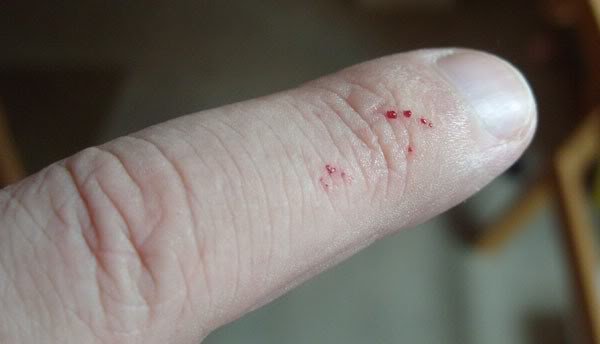The Beginner's Guide to Snake-Keeping
Introduction
So you've decided to get a pet snake. But it's not as simple as going to the pet shop and just buying any of the snake there. There are a few considerations that you need to know first. So let's get started.
Choosing the Right Snake
The two most commonly kept snake families are Pythons (Pythonidae) and Colubrids (Colubridae). Pythons, portrayed as huge man-eating snakes actually come in a variety of size and temperaments, while Colubrids are usually smaller sized and more docile in nature.
Examples of Pythons : Ball python, Burmese Python, Reticulated Python and others.
Examples of Colubrids : Corn snake, King Snake, Rat Snakes and more.
Most of the snake species in the hobby usually come in a large variety of colors, or what people refer to as 'morphs'.

A group of different corn snake morphs (Pic taken from http://cjspets.com)
The best snake is always the snake that you can afford and maintain. For example, if you live in a small apartment, there's no sense in getting a baby Burmese python as they can grow up to 12 - 20 feet in length. (Wild specimens which are 20+ feet have also been discovered)
Pythons are usually on the larger size (with some exceptions like Ball Pythons) while Colubrids are on the smaller scale, once you've decided which one to get, then only you should think about the morph. Although some morphs look really cool and all, it only brings aesthetic differences as inside they are still the same species.
The Environment
So you've already thought about which snake you want, now you have to prepare a home for them.
Snakes are cold-blooded animals. Meaning unlike us, they can't regulate their body temperature. Instead, they depend on the ambient temperature to heat/cool their body.
With that said, you will need to be aware of the temperature limits in your country. If you live in a tropical country, then there shouldn't be any issues. But if your country has a colder period (eg. Winter), you would need to get heaters or lamps to maintain the temperature. Failing so, the snake might go into hibernation or worse, die.
Next, you would need to get an enclosure for your snake. You can either buy pre-made ones from exotic pet brands (Exo-Terra, Zoo Med) or you can custom build your own.
Ideally, if you are not experienced in building enclosures for snakes, it's easier to just get a premade one.
Bigger snakes like the Burmese python would definitely require a custom made enclosure due to their enormous adult size.
Setting Up
Once you've got a ideal cage/enclosure/tank for your new pet, it's time to decorate it.
There is just 3 main things you need for your snake to be happy in its new home.
- Hide
- Substrate
- Water Dish
The hide can be as simple as a empty ice cream tub with a hole cut in front and turned upside down to be a make-shift cave. Pet shops also do sell snake hides which are made of more durable and heavier material.
For the substrate, the cheapest and most simple choice would be used newspaper. Once the snake defecates on top, its super easy to clean up and replace, not to mention economical. If you can afford to spend more, there are other substrate choices like wood chips or grinded coconut husks. These simulate a natural environment for the snakes where they can burrow underneath and they absorb bad odors much better than normal newspaper.
As for the water dish, it's best that you use a one that is heavy enough so that the snake won't knock it over while slithering around. Something made of ceramic is pretty good and easy to wash. Snakes have a tendency to defecate in the water bowls.
Feeding
So you've finished setting up your snake's home. Now it's time to get food for them.
Most or all of the snake species that are kept in the hobby generally consume rodents for their diet. And pet shops that sell snakes will always have an ample supply of feeder mice and rats for sale.
You can either buy live feeders or you can opt for frozen ones. Frozen feeders are pre-killed and usually sold in bulk. This can be quite convenient for people who do not want to go out and get a live mice everytime they need to feed their snake. The frozen feeders can be kept in your freezer, and taken out to be defrosted when needed.
Snakes only need to be fed once every two weeks. You can choose to feed them every week but usually only breeders do that to fatten them up for breeding purposes. Some bigger snakes like the Burmese only eats once a month, as you would typically need to buy a rabbit or chicken for snakes that size.
To feed your snake, buy a pair of metal tongs to grip the feeder. Then slowly lower them into your snake's enclosure. Your snake will immediately detect the scent and proceed to attack and coil around the prey.
You can use your hands of course, but bear in mind the snake might bite your hand accidentally instead, their eyesight aren't the best.
If you are feeding live, you can leave the mice/rat in the enclosure for the snake. If they are not eaten in an hour, it's best to remove the feeder as they might actually attack and seriously injure your snake. (Rats can be quite vicious when they are hungry)
Note : Do NOT feed your snake hamsters. Not only they are expensive, hamsters will aggressively bite and kill your snake in self-defence when attacked.
Handling
When you first bring home your pet snake, it is advisable to not handle them too much and let them ease in to their new home. You should probably leave them alone for 2 - 3 days.
To pick up your snake, the correct way is to scoop them up from below, instead of picking them up from above. Snake's natural predators in the while are birds, they hunt them by swooping down from above. Because of this, snakes are naturally defensive towards anything that makes a shadow from above.
Avoid sudden or jerky movements with your hand while handling your snake. Some snakes are rather lazy and won't move much in your hands, while some are quite active and they will try to escape your grip. Instead of controlling them and gripping harder, it's better to redirect them with your other hand. Gripping them simulates the feeling of bring grabbed by a predator and it would definitely trigger their defense mechanism, causing them to strike at you.
So what happens if you get bitten? Nothing to worry, if your snake isn't a giant Burmese or Reticulated python, all you need to to just waste your wound with water and maybe disinfect it with some ointment. Snake keepers are bound to get bitten and you will eventually get use to it.
Conclusion
Snakes are interesting and easy to keep pets for someone who are looking for something different than the usual fare of house pets.
Best of all, they can live up to 30 years! So make sure you are able to commit before deciding to get one as a pet.

Hey :) Up.
Amazing one photo! Good article :)
@kamilkowalski
Bro the first pic is it ur pic? If its not ur pic u must give credit to source otherwise its plagiarism.
Whoops, left that out. Thanks for reminding.
no worries mate, we are here to watch each other's back. welcome bro.